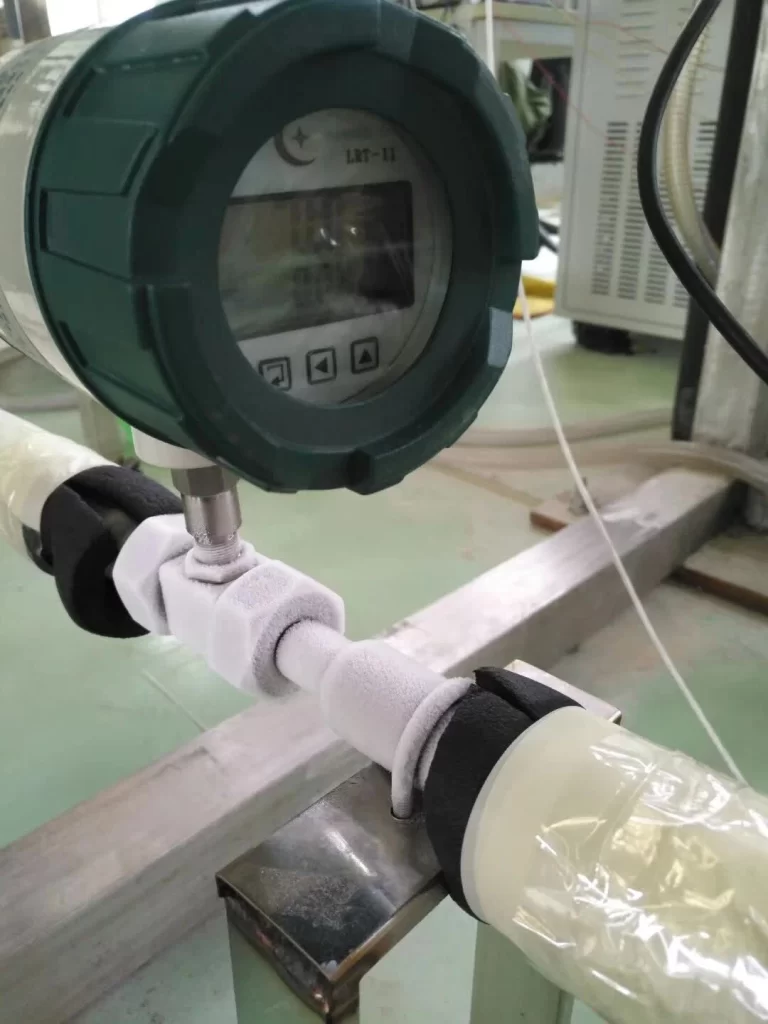So far, there are as many as 60 Flow Meter Types available for industrial use. The reason why there are so many varieties is that so far we have not found a flow meter that is suitable for any fluid, any range, any flow state and any use conditions.
Each of these 60 kinds of flow meters has its specific applicability and limitations. According to the measurement principles, there are mechanical principles, thermal principles, acoustic principles, electrical principles, optical principles, atomic physics principles, etc. According to the most popular and extensive classification method at present, it is divided into: volumetric flowmeter, differential pressure flowmeter, float flowmeter, turbine flowmeter, electromagnetic flowmeter, vortex flowmeter, ultrasonic flowmeter, mass flowmeter wait.
Here we have selected the 11 most commonly used flow meters to introduce and analyze their advantages and disadvantages.

We have introduced the definition of flow measurement and flow meter in the blog “Flow Measurement 101“. If you are a newbie, you can refer to it.
Next, let’s take a look at 11 Flow Meter Types and Their Advantages and Disadvantages.
Electromagnetic Flowmeter
working principle
The electromagnetic flowmeter is an instrument for measuring conductive liquids based on Faraday’s law of electromagnetic induction. Electromagnetic flowmeters have a series of excellent characteristics that can solve problems that are difficult to apply with other flowmeters, such as the measurement of dirty flows, mud, and corrosive flows.
advantages and disadvantages
Advantage:
- The measurement channel is a smooth straight tube and will not be blocked. Suitable for measuring liquid-solid two-phase fluids containing solid particles, such as pulp, mud, sewage, etc.;
- There is no pressure loss caused by flow detection, and the energy saving effect is good;
- The measured volumetric flow rate is virtually unaffected by changes in fluid density, viscosity, temperature, pressure and conductivity;
- Large flow range and wide caliber range;
- Corrosive fluids can be used.
Disadvantages:
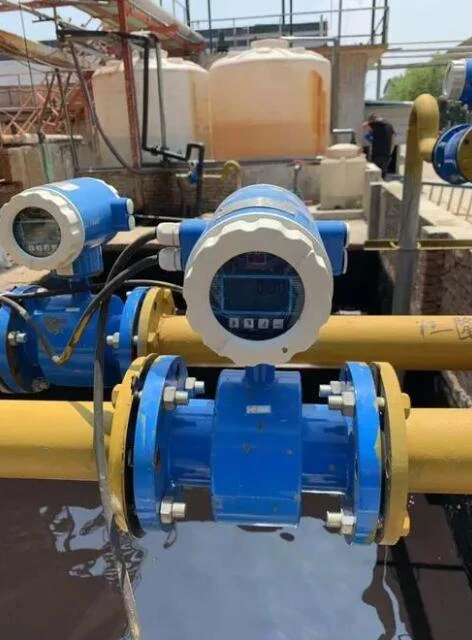
- Liquids with very low conductivity, such as petroleum and oil products, cannot be measured;
- Cannot measure gas, steam and liquids containing large bubbles;
- Cannot be used at higher temperatures.
Applications
Electromagnetic flowmeters have a wide range of applications.
Large-diameter instruments are mostly used in water supply and drainage projects.
Small and medium diameters are often used in high-demand or difficult-to-measure situations, such as blast furnace tuyere cooling water control in the steel industry, measurement of pulp liquid and black liquor in the papermaking industry, strong corrosive liquids in the chemical industry, and slurry in the nonferrous metallurgical industry.
Small diameter and micro diameter are often used in the pharmaceutical industry, food industry, biochemistry and other places with hygienic requirements.
Electromagnetic flowmeter can also be used for Partially Filled Pipe flow measurement.
Learn more about Magnetic Flowmeter Technology and choose Magnetic Flow Meters for your applications.
Turbine flowmeter
working principle
Turbine flowmeter is the main type of velocity flowmeter. It uses a multi-blade rotor (turbine) to sense the average flow velocity of the fluid and derive the flow rate or total amount.
Generally, it consists of two parts: sensor and display, and can also be made into an integral type.
advantages and disadvantages
Advantages:
- High precision, among all flow meters, it is the most accurate flow meter;
- Good repeatability;
- Zero point drift, good anti-interference ability;
- wide range;
- Compact structure.
Disadvantages:
- Unable to maintain calibration characteristics for a long time;
- Fluid physical properties have a great influence on flow characteristics.
Applications
Turbine flowmeters are widely used in the following measurement objects: petroleum, organic liquids, inorganic liquids, liquefied gases, natural gas and cryogenic fluids. In Europe and the United States, turbine flowmeters are second only to orifice flowmeters in terms of natural measurement meter.
Learn more about Turbine Flowmeter Technology and choose Turbine Flow Meters for your applications.
Vortex flowmeter
working principle
The vortex flowmeter is an instrument in which a non-streamlined vortex generator is placed in the fluid. The fluid alternately separates and releases two series of regularly staggered vortexes on both sides of the generator.
Vortex flowmeters can be divided according to frequency detection methods: stress type, strain type, capacitive type, thermal type, vibration type, photoelectric type and ultrasonic type, etc.
advantages and disadvantages
Advantages:
- Simple and solid structure;
- Applicable to many types of fluids;
- Higher accuracy;
- Wide range;
- The pressure loss is small.
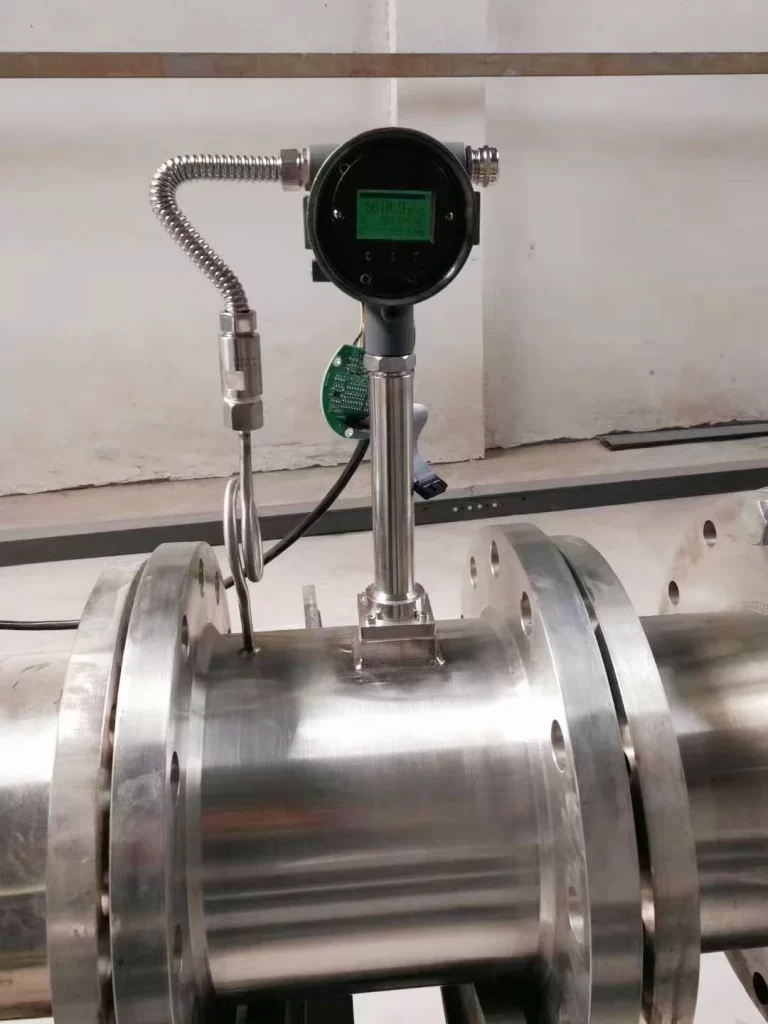
Disadvantages:
- Not suitable for low Reynolds number measurements;
- A longer straight pipe section is required;
- Lower instrument coefficient (compared to turbine flowmeter);
- The instrument still lacks application experience in pulsating flow and multi-phase flow.
applications
Vortex flowmeter is suitable for measuring various liquid media, such as water, petroleum, chemicals, solutions, etc.
At the same time, it is also suitable for measuring various gas media, such as air, natural gas, nitrogen, etc.
In addition, vortex flowmeters can also be used to measure steam flow.
Vortex flowmeters can measure over a wide temperature and pressure range. Generally, vortex flow meters can adapt to the temperature range from -200°C to +400°C and the pressure range from vacuum to high pressure.
Learn more about Vortex Flowmeter Technology and choose Vortex Flow Meters for your applications.
Ultrasonic flow meter
working principle
Ultrasonic flowmeter is an instrument that measures flow by detecting the effect of fluid flow on ultrasonic beams (or ultrasonic pulses). According to the principle of signal detection, ultrasonic flowmeters can be divided into propagation velocity difference methods (direct time difference method, time difference method, phase difference method and frequency difference method), beam offset method, Doppler method, cross-correlation method, and spatial filtering method. and noise method, etc.
Ultrasonic flowmeters are the same as electromagnetic flowmeters. Because there are no obstructions in the flow channel of the instrument, they are both unobstructed flowmeters. They are a type of flowmeter suitable for solving difficult problems of flow measurement, especially in large-diameter flow measurement. The advantages.
advantages and disadvantages
Advantages:
- Non-contact measurement is possible;
- Measurement without flow obstruction and no pressure loss;
- It can measure non-conductive liquids and is a supplement to the electromagnetic flowmeter for non-obstruction measurement.
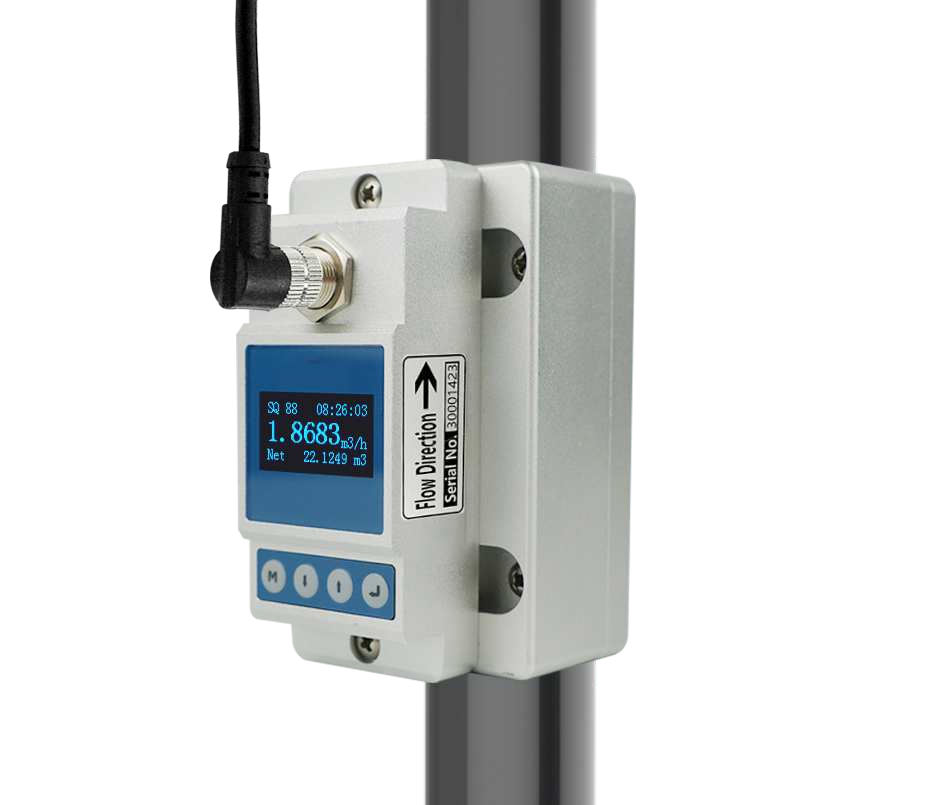
Disadvantages:
- The travel time method can only be used for clean liquids and gases; while the Doppler method can only be used to measure liquids containing a certain amount of suspended particles and bubbles;
- The measurement accuracy of Doppler method is not high.
Application
The transit time method is applied to clean, single-phase liquids and gases. Typical applications include tap water, diesel, etc.
In terms of gas applications, we have good experience in the field of high-pressure natural gas;
The Doppler method is suitable for two-phase fluids with a low heterogeneous content. For example: raw sewage, factory effluents, dirty process fluids; generally not suitable for very clean liquids.
Learn more about Ultrasonic Flow Meter Technology and choose Ultrasonic Flow Meters for your applications.
In addition to being used in flow measurement, ultrasonic technology has also been applied to liquid level measurement, providing an excellent liquid level measurement solution!
Coriolis mass flow meter
working principle
Coriolis mass flow meter This flow meter is a novel instrument that directly and precisely measures fluid mass flow. The main structure uses two side-by-side U-shaped tubes, and the bent parts of the two tubes vibrate slightly toward each other, and the straight tubes on both sides will vibrate accordingly. That is, they will move closer or open at the same time, that is, the vibrations of the two tubes are synchronous and symmetrical.
If the fluid is introduced into the tube and flows forward along the tube while the tube is vibrating synchronously, the tube will force the fluid to vibrate up and down with it.
advantages and disadvantages
Advantages
- Coriolis mass flow meters directly measure mass flow and have high measurement accuracy.
- A wide range of measurable fluids. Various liquids including high viscosity liquids, slurries containing solids, liquids containing trace amounts of gas, and medium and high pressure gases with sufficient density.
- The vibration amplitude of the measuring tube is small and can be regarded as an inactive part. There are no obstructions and movable parts in the measuring pipeline.
- It is not sensitive to the upstream flow velocity distribution, so there is no requirement for upstream and downstream straight pipe sections.
- The measured value is insensitive to fluid viscosity, and changes in fluid density have little impact on the measured value.
- Can perform multi-parameter measurements. Just like measuring density, temperature, and derived from this measure the concentration of solute contained in a solution.
Disadvantages
- The zero point of the Coriolis mass flowmeter is unstable and causes zero point drift, which affects the further improvement of its accuracy. As a result, many models of instruments have to divide the total error into two parts: basic error and zero-point instability measurement.
- Coriolis mass flow meters cannot be used to measure low-density media and low-pressure gases. The gas content in the liquid above a certain limit (varies by model) can significantly affect the measured values.
- Coriolis mass flow meters are sensitive to external vibration interference. In order to prevent the influence of pipeline vibration, most models of Coriolis mass flow meters have relatively high requirements for installation and fixation of flow sensors.
- It cannot be used for larger pipe diameters, currently limited to less than 200mm.
- Wear, corrosion or sedimentation of the inner wall of the measuring tube will affect the measurement accuracy. This is especially true for Coriolis mass flow meters with thin-walled tube measuring tubes.
- Most models of Coriolis mass flow meters are heavy and bulky.
- expensive. The ordinary price is 5,000 to 10,000 US dollars for a set, which is about 2 to 8 times that of electromagnetic flowmeters of the same caliber.
Applications
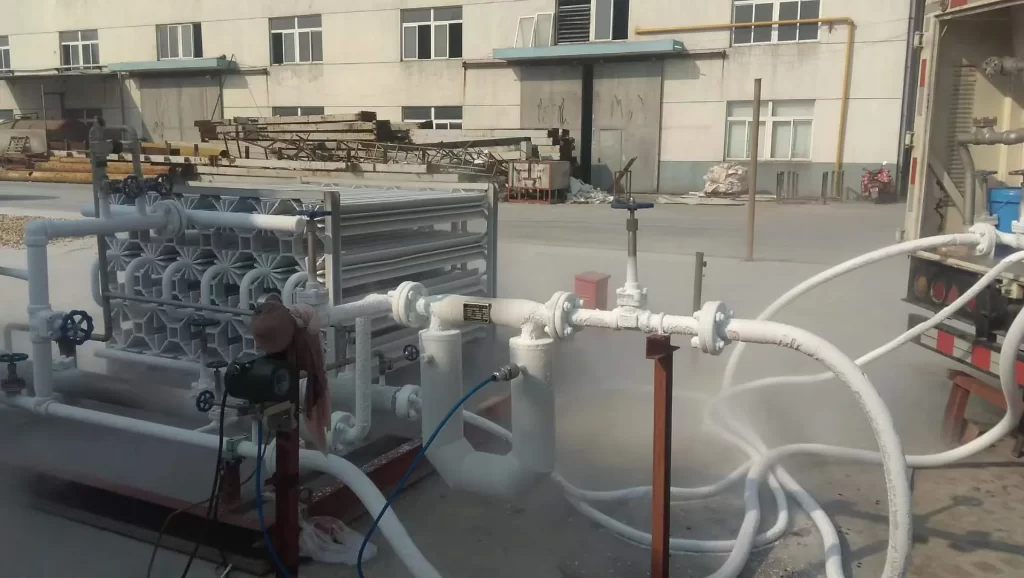
Coriolis mass flow meters are the best choice for applications like:
- Food & Beverage
- Pulp and paper
- Petrochemical
- Oil & Gas
- Power
- High Viscosity
- Paint
- Mining
- Process Control
- Water and wastewater
- And numerous other industries
Learn more about Coriolis Mass Flow Meter Technology and choose Mass Flow Meters for your applications.
Thermal mass flow meter
working principle
Thermal flow meter sensors contain two sensing elements, a speed sensor and a temperature sensor. They automatically compensate and correct for gas temperature changes.
The electric heating part of the instrument heats the speed sensor to a certain value higher than the working temperature, so that a constant temperature difference is formed between the speed sensor and the sensor that measures the working temperature. When the temperature difference is kept constant, the energy consumed by electric heating, which can also be said to be the heat dissipation value, is proportional to the mass flow rate of the gas flowing through it.
advantages and disadvantages
Advantages
- High reliability
- Good repeatability
- High measurement accuracy
- Small pressure loss
- No moving parts
- Range ratio wide
- quick response
- No temperature and pressure compensation required
Disadvantages
- Due to changes in cp value and thermal conductivity, the measured value will change greatly and cause errors;
- If the gas being measured is scaled on the tube wall, it will affect the measured value, and it has the disadvantage of being easily blocked;
- Thermal mass flow meters for pulsating flows and liquids will be limited in their use for viscous liquids.
- The gas is required to be dry and pollution-free: Gas with high humidity affects the heat exchange on the sensor surface, which in turn affects the output results. Particulate matter also has an impact on sensor output.
- Not suitable for high viscosity gases: For high viscosity gases, the performance of the thermal gas mass flow meter may be affected. Because the heat transfer characteristics of the gas will change.
Applications
Thermal gas mass flow meter is a new instrument used to measure and control gas mass flow.
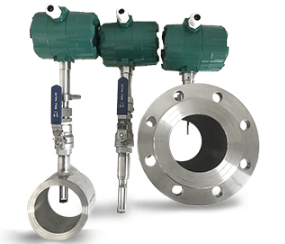
- Gas mass flow measurement in industrial pipelines
- Measurement of flue gas flow rate from chimney
- Calciner flue gas flow measurement
- Air flow measurement in gas process
- Compressed air flow measurement
- Gas flow measurement during half-channel body chip manufacturing process
- Gas flow measurement in sewage treatment
- Gas flow measurement in heating ventilation and air conditioning systems
- Flux recovery system gas flow measurement
- Combustion gas flow measurement in combustion boilers
- Gas flow measurement of natural gas, flare gas, hydrogen and other gases
- Carbon dioxide gas flow measurement during beer production
- Gas mass flow measurement in the production process of cement, cigarette and glass factories
Learn more about Thermal Mass Flow Meter Technology and choose Thermal Mass Flow Meters for your applications.
Volumetric flow meter
working principle
Positive displacement flowmeter, also known as fixed displacement flowmeter, or PD flowmeter for short, is the most accurate type of flow meter.
It uses mechanical measuring elements to continuously divide the fluid into a single known volume part. The total volume of the fluid is measured based on the number of times the measuring chamber is filled and discharged with the fluid in this volume part.
Volumetric flowmeters are classified according to their measuring components and can be divided into oval gear flowmeters, scraper flowmeters, double rotor flowmeters, rotating piston flowmeters, reciprocating piston flowmeters, circular gear flowmeters, and liquid-sealed rotary drum flowmeters. , wet gas meter and membrane gas meter, etc.
advantages and disadvantages
Advantages:
- High measurement accuracy;
- Installation pipeline conditions have no impact on measurement accuracy;
- Can be used for measurement of high viscosity liquids;
- wide range;
- The direct-reading instrument can directly obtain the accumulation and total quantity without external energy, which is clear and easy to operate.
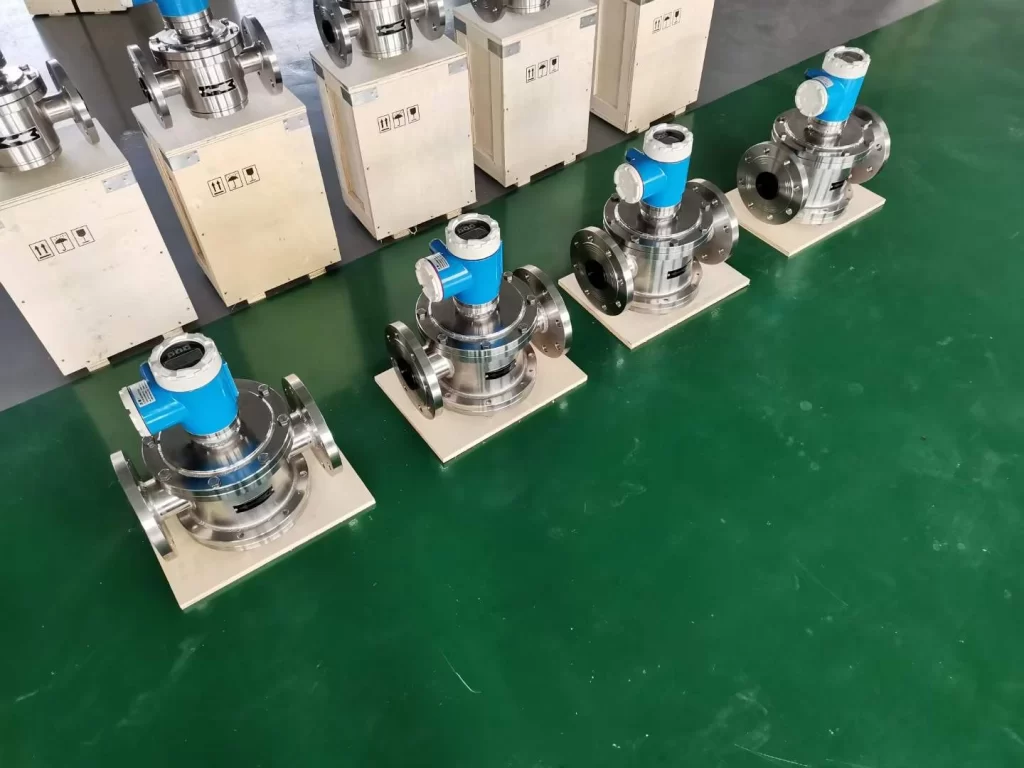
Disadvantages:
- The results are complex and bulky;
- The type, caliber, and working status of the medium to be measured have great limitations;
- Not suitable for high and low temperature situations;
- Most instruments are only suitable for clean single-phase fluids;
- Produces noise and vibration.
Applications
Volumetric flowmeters, differential pressure flowmeters and float flowmeters are among the three most commonly used flowmeters and are often used for total volume measurement of expensive media (oil, natural gas, etc.).
Learn more about Volumetric Flow Meters: Comprehensive Guide and Product List.
Differential pressure flow meter
working principle
A differential pressure flowmeter is an instrument that calculates flow based on the differential pressure generated by the flow detection component installed in the pipeline, the known fluid conditions, and the geometric dimensions of the detection component and the pipeline.
The differential pressure flow meter consists of a primary device (detection component) and a secondary device (differential pressure conversion and flow display instrument). Differential pressure flowmeters are usually classified in the form of test pieces, such as orifice flowmeters, Venturi flowmeters, velocity-averaging tube flowmeters, etc.
The secondary devices are various mechanical, electronic, electromechanical integrated differential pressure gauges, differential pressure transmitters and flow display instruments.
The detection parts of differential pressure flow meters can be divided into several categories according to their working principles: throttling device, hydraulic resistance type, centrifugal type, dynamic head type, dynamic head gain type and jet type.
advantages and disadvantages
Advantages:
- The most widely used orifice flow meter has a solid structure, stable and reliable performance, and long service life;
- It has such a wide range of applications that no other type of flow meter can compare with it so far;
- The detection parts, transmitters, and display instruments are produced by different manufacturers to facilitate production with economies of scale.
Disadvantages:
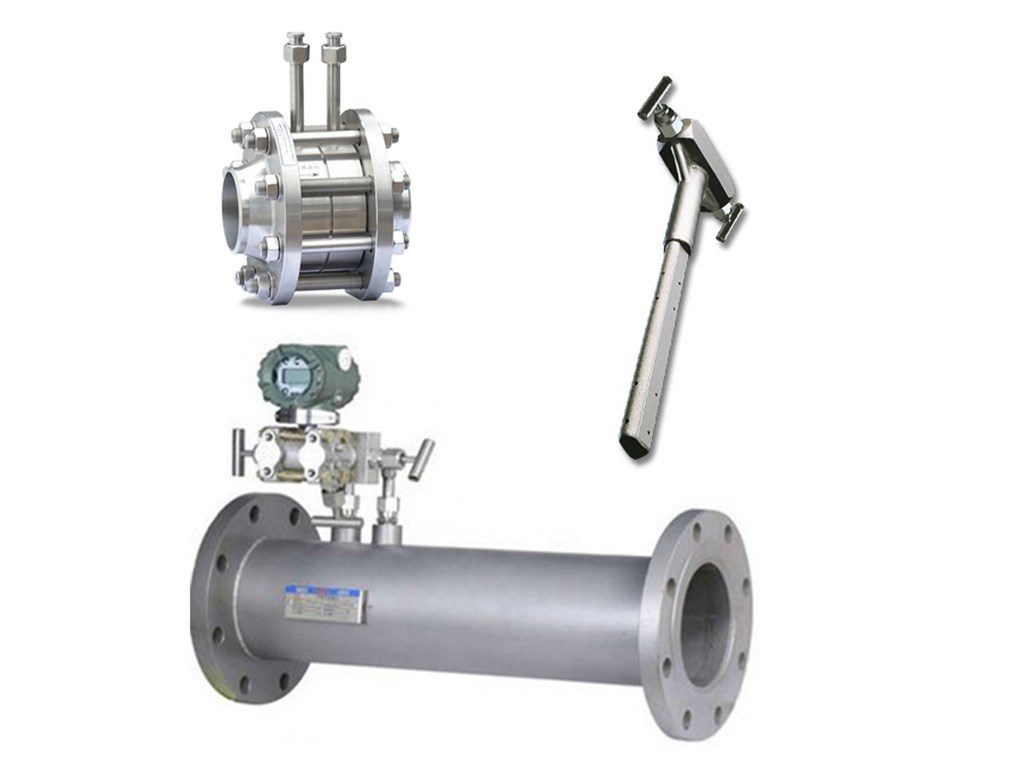
- Measurement accuracy is generally low;
- The range is narrow, generally only 3:1~4:1;
- The requirements for on-site installation conditions are high;
- Large pressure loss (referring to orifice plate, nozzle, etc.).
Applications
- Differential pressure flow meters have a particularly wide range of applications. Various objects have applications in flow measurement of closed pipes.
- For example, in terms of fluids: single phase, mixed phase, clean, dirty, viscous flow, etc.;
- Working status: normal pressure, high pressure, vacuum, normal temperature, high temperature, low temperature, etc.;
- In terms of pipe diameter: from several mm to several meters;
- Flow conditions: subsonic, sonic, pulsating flow, etc.
Learn more about Differential Pressure Flow Meter Technology and choose Differential Pressure Flow Meters for your applications.
Float flowmeter
working principle
The float flowmeter, also known as the rotor flowmeter, is a type of variable area flowmeter. In a vertical tapered tube that expands from bottom to top, the gravity of the float with a circular cross-section is borne by the liquid power, so that the float Can rise and fall freely within the conical tube.
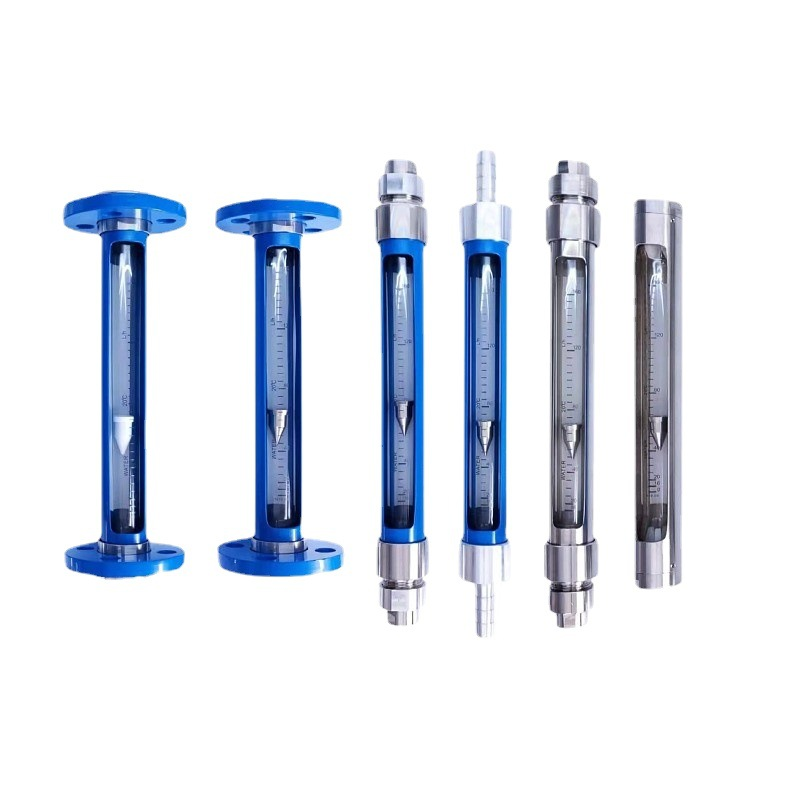
The float flowmeter plays a decisive role in small and micro flow.
advantages and disadvantages
Advantages:
- The glass cone tube float flowmeter has a simple structure and is easy to use.
- Suitable for small pipe diameters and low flow rates;
- Pressure loss is low.
- Good stability: Since the measuring element of the float flowmeter is not in direct contact with the fluid, it will not be affected by changes in the physical properties of the fluid and has good stability.
Disadvantages are low pressure resistance and a greater risk of the glass tube being fragile.
Metal rotor flowmeter
working principle
The float of the metal tube rotor flowmeter is in the measuring tube. As the flow rate changes, the float moves upward. At a certain position, the buoyancy force on the float and the gravity of the float reach a balance.
At this time, the flow annular area between the float and the orifice plate (or tapered tube) remains constant. The annulus area is proportional to the rising height of the float. That is, the rising position of the float in the measuring tube represents the flow rate. The changing position of the float is transmitted to the external indicator by the internal magnet, allowing the indicator to correctly indicate the flow value at this time. .
This prevents the indicator housing from being in direct contact with the measuring tube. Therefore, even if a limit switch or transmitter is installed, the instrument can be used under high temperature and high pressure working conditions.
advantages and disadvantages
Advantages:
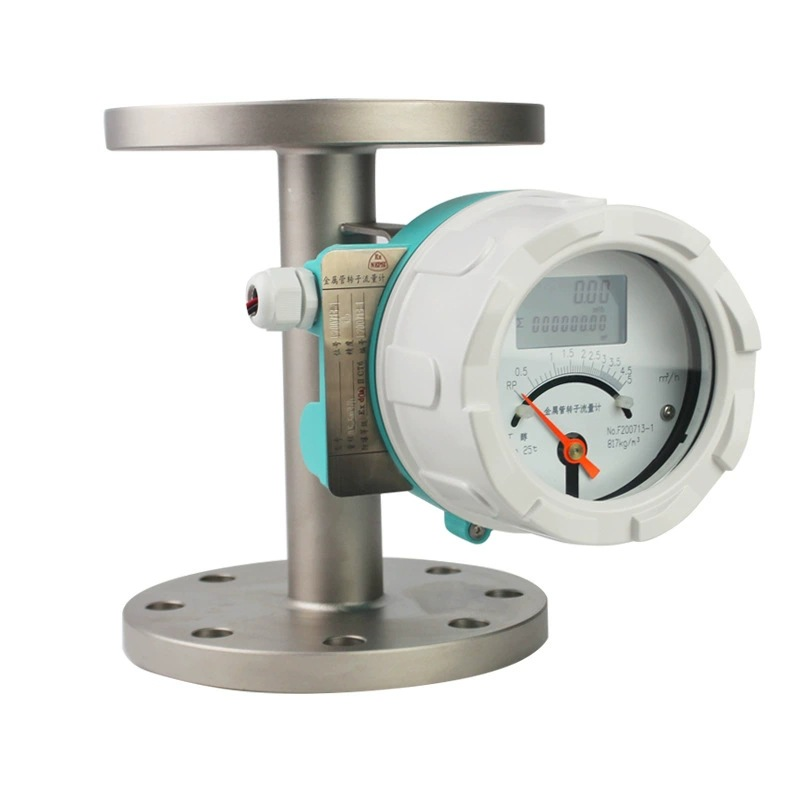
- Sturdy, simple, reliable, with low maintenance and long life.
- Modular, intelligent, indicator design.
- The requirements for the downstream straight pipe section are not high.
- It has a wide flow range of 10:1.
- Short stroke, small structure design.
- Realize soft output through HART to display instantaneous and cumulative flow. Switch signal output, on-site setting and adjustment of media parameters, on-site performance compensation.
- Multi-level correction of medium viscosity, density, temperature and pressure.
- There are many types such as local type, remote transmission type, jacket type, explosion-proof, corrosion-resistant type, sanitary type, etc.
- Stainless steel, Hastelloy, titanium, and PTFE material measurement systems are available.
- Low pressure loss design.
- Vertical, horizontal and various installation methods are more suitable for different use occasions.
- All-metal structure, suitable for high temperature, high pressure and highly corrosive media.
- Can be used in flammable and explosive hazardous locations.
Disadvantages:
- The application of float flowmeter is limited to small and medium pipe diameters. It cannot be used for large pipe diameters, and the maximum diameter is generally DN150mm.
- When the fluid used is different from the factory calibration fluid, the flow indication must be corrected. Float flowmeters for liquids are usually calibrated with water, and gases with air. If the density and viscosity of the actual fluid used are different, the flow rate will deviate from the original graduation value, and conversion corrections must be made.
Applications
Metal tube float flowmeter is a variable area flow measurement instrument commonly used in industrial automation process control.
Can be used to measure the flow of liquids, gases and steam. It is especially suitable for medium flow measurement with low flow rate and small flow rate. Commonly used are water and air measurements.
open channel flow meter
working principle
The working principle of the open channel flowmeter is to use open channel technology to measure the fluid level and then calculate the flow rate through the microprocessor inside the instrument.
Due to non-contact measurement, open channel flow meters can be used in harsher environments.
Under the control of a microcomputer, the open channel flowmeter transmits and receives the open channel, and calculates the distance between the open channel flowmeter and the measured liquid surface based on the transmission time, thereby obtaining the liquid level height. Since there is a certain proportional relationship between the liquid level and the flow rate, the liquid flow rate Q can be finally obtained according to the calculation formula.
advantages and disadvantages
Advantages:
- The measurement range is large, and the flow measurement is not affected by the return water on the tributary surface.
- During measurement, it is not affected by sediment, bubbles and large changes in water level floating in the water. The flow sensor produces resistance to the flow of water. It has a simple structure, small size and is easy to install.
- Standard channels can be installed directly without modification, and the installation and construction costs are low.
- The instrument has complete display and output functions. It can display measurement data such as water level, flow velocity, flow rate, cumulative flow rate, etc. It also has an RS-485 communication interface.
- It has alarm functions for water level, mud level and flow rate exceeding limits.
- It has a data saving function that can save setting parameters and flow values in the event of a long-term power outage.
Disadvantages:
- In actual use, changes in water quality will affect the measurement results, especially when the water contains suspended matter or sediment with larger particles, which will cause the flow meter to become clogged or the readings will be inaccurate;
- In open watercourses, channels or drainage systems this requires extensive excavation work.
- Not suitable for high viscosity fluids.
- Parshall troughs and weir troughs, etc. need to be installed;
- A certain amount of installation space is required;
- A mounting bracket is required.
Applications
Ultrasonic open channel flowmeter is suitable for measuring the flow of rectangular, trapezoidal and U-shaped open channels in reservoirs, rivers, water conservancy projects, urban water supply, sewage treatment, farmland irrigation, water administration and water resources.
Ultrasonic open channel flow meters need to be measured together with weirs and troughs. Commonly used weirs and troughs include Parshall troughs, rectangular troughs, triangular weirs, etc. The appropriate matching method can be selected according to different site environments.

Understanding the various types of flow meters is only half the battle in choosing the right one for you. You can learn more details in our flow meter selection guide to choose the best flow meter for your measurement!
More Flow Measurement Solutions
- Top 3 Flow Meters for PVC Pipes
- Pipe Flow vs Pressure – Relationship & Calculate Tools
- Top 4 Types of Pipeline Flow Meters-DN6~DN1000~DN6000
- Flow Measurement 101
- What Is Solvent Flow Meter? Industrial Selection Guide
- What Is a BTU Meter? | BTU Energy Measurement Systems
- Mechanical Flow Meter 101-Mechanical Flowmeters Selection Guide
- Bidirectional Flow Meters | Electromagnetic, Ultrasonic, Mass and Porous Orifice Flowmeter
- Volumetric Flow Meters: Comprehensive Guide and Product List
- Choosing the Right Inline Water Flow Meter
- Portable Ultrasonic Flowmeters | Best Price for Easiest Measurement
- Industrial Inline Flow Meters | Selection List
- High-Performance Marine Fuel Flow Meters | Save Your Costs!
- Industrial Fuel Flow Meters – Choose the Right one for You
- Mass Flow Rate and Volumetric Flow Rate: Key Differences and Conversion
- Top Guide to CO2 Flow Meters
- Ultrasonic Clamp on Flow Meter for Quick & Easy Measurements
We at Sino-Inst produce and supply common industrial flow meters, including: electromagnetic flow meters, turbine flow meters, vortex flow meters, ultrasonic flow meters, Coriolis mass flow meters, oval gear flow meters, non-full tube electromagnetic flow meters, etc. More than 50 species.
Our flow meters are widely used in production and processes in various industries. Including customization for high temperature, extremely low temperature, high viscosity, corrosion and other special media measurements. If you need to purchase a flow meter or have any questions, please feel free to contact us.
-1.jpg)
